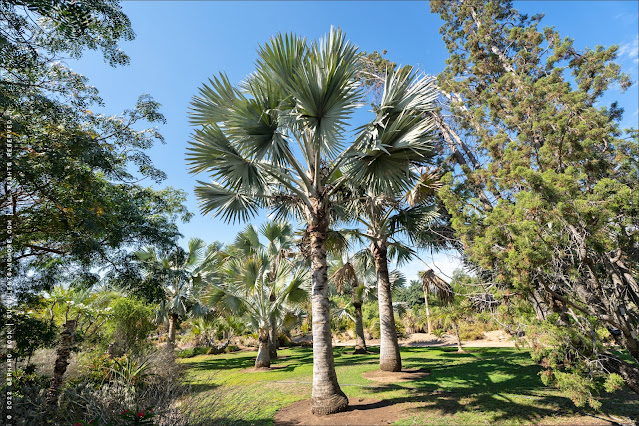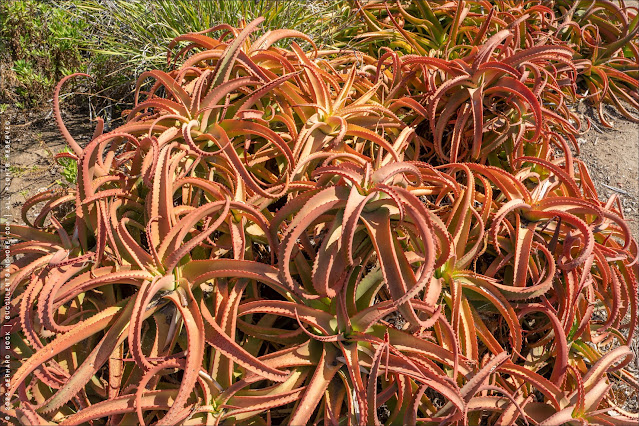Let's continue our walk through the Los Angeles County Arboretum and Botanic Garden. If you missed part 1, you can find it here.
The first photo I took on this visit was of a rainbow eucalyptus (Eucalyptus deglupta) growing in the middle of the lawn area adjacent to Ayres Hall where the Inter-City Cactus and Succulent Show was held. I've seen rainbow eucalyptus thrive in Hawaii—no surprise, seeing how the climate there is similar to its native habitats in the Philippines, Indonesia, and Papua New Guinea—but inland Los Angeles County is a more surprising location for this frost-tender gum. If there's a tree with more colorful bark, I'm not aware of it.
 |
| Rainbow eucalyptus (Eucalyptus deglupta), native to Philippines, Indonesia, and Papua New Guinea and the only eucalypt living in a rainforest environment. So beautiful, so frost-tender. Impossible to grow here in Davis. |
Speaking of trees, there are plenty of special specimens at the LA County Arboretum. Some stand out for their size, like the Peruvian pepper (Schinus molle) a few photos down, others because they flower so heavily, you can hardly see the leaves:
 |
| One of the most floriferous crepe myrtles (Lagerstroemia indica)... |
 |
| ...I've ever seen |
 |
| Peruvian pepper tree (Schinus molle) |
When I visit a public garden, I often just walk around without a real destination in mind. This time it was a little different. As she describes
in this post on her blog,
the danger garden, my friend Loree Bohl happened to stumble upon the LA County Arboretum's collection of epiphytic cactus, and I wanted to see it for myself. It looks like I
just missed a nice display on these vining
Hylocereus, the cactus that gives us dragonfruit:
 |
| Hylocereus a day after flowering |
None of the orchid cactus (Epiphyllum species and hybrids) were in flower. They must be spectacular when in bloom in late spring.
 |
| Epiphyllums in hanging pots |
 |
| Another vining cactus that had just bloomed |
While I didn't see flowers on any of the epiphytic cacti, I did see something maybe even more exciting, but definitely more bizarre:
 |
| Aristolochia gigantea, aka giant Dutchman's pipe or pelican flower, is a vigorous vine native to Brazil |
 |
| It has massive flowers, up to 6" wide and 12" tall |
 |
| To me, the flowers look alien... |
 |
| ...like sleeping creatures from outer space |
A couple of snapshots on my way to the Bismarck palm meadow:
 |
| Bamboo sculpture and... |
 |
| ...clump of bananas |
Bismarck palms (Bismarckia nobilis) are native to the open grasslands of western and northern Madagascar. If I could grow one palm in the ground, it would be a Bismarck palm. They're not very hardy, but our winters would be mild enough now (thank you, climate change). I simply don't have the room. I do love their elegant form and especially their steely blue leaves:
 |
| Bismarckia nobilis |
I'm hoping my next garden, wherever and whenever it will be, will be large enough for Bismarck palm or two.
The Spiny Madagascar Forest garden is right next to the Bismarck palm meadow. Many of these plants are endangered in their native habitat; as is so often the case, the biggest threat is development.
This Pacific Horticulture article offers an in-depth look at the development of the Spiny Madagascar Forest at the LA County Arboretum.
 |
| Aloe vaombe and Euphorbia millii |
 |
| The white-flowering plants are Pachypodium lamerei. They're sometimes called Madagascar palms, although they're not remotely related to palms (they're members of the same subfamily as the oleander). |
 |
| Cynanchum grandidieri, a vine in the milkweed family |
 |
| Alluaudia procera. In the US, it's often called the “Madagascar ocotillo” (a name I hate) although it has nothing in common with the ocotillo other than a superficial resemblance. In Malagasy, it's called “fantsilohitra.” |
I completed my loop via the Aloe Trail. There was nothing in flower other than a couple of Aloe tomentosa, beautiful in their own right:
 |
| Aloe tomentosa and... |
 |
| Euphorbia resinifera |
 |
| Euphorbia horrida |
 |
| Euphorbia polygona 'Snowflake' |
 |
| Most of the aloes looked like this |
 |
| I think large expanses of the aloe collection don't get much, if any, supplemental water in the summer. |
 |
| Two Aloidendron barberae |
 |
| Aloe marlothii |
 |
| Dragon tree (Dracaena draco) from the Canary Islands |
As I mentioned in
part 1, my ambition to explore the Arboretum ended up being greater than my desire to walk far in the 60%+ humidity, an artefact from the heavy monsoons that flooded Las Vegas and Death Valley.
Coming up next: photos from the 2022 Inter-City Cactus and Succulent Show!
© Gerhard Bock, 2022. All rights reserved. To receive all new posts by email, please subscribe here.

































Fantastic photos, Gerhard! The LA Arboretum should pay you to do their publicity photos ;) I've always loved the Eucalyptus with the rainbow trunks, which have been there forever. Seeing the Arboretum's succulent areas always leaves me wondering why it's sister South Coast Botanic Garden hasn't figured out how to plant its own "Desert Garden" so it doesn't look thrown together. Almost all the original plants at SCBG came from the Arboretum but I don't know if they provide plants any more. SCBG's land is also owned by LA County and the staff members responsible for maintenance are County employees.
ReplyDeleteThere are some fantastic plants in the arboretum. Your photos as always capture the whole feel of the garden. Gorgeous! The butterfly house in our own small botanical garden grows Aristolochea gigantea (indoors of course) for some of the butterflies. Apparently they are attracted to the 'carrion' colouration of the flowers.
ReplyDeleteGood photos and interesting comments. The Bismarkias there have really shot up. I have a picture somewhere from when they were the same height as me.
ReplyDeleteA number of fantastic tree trunks in this post, starting with the colorful eucalyptus, followed by the Peruvian pepper tree, ending with photo 22, where the trunk is staring right at us and whistling!
ReplyDeletechavli
Sexy Bismarckia nobilis and a look at the jungle cactus, what fun. It was also interesting to see your photos (and the garden through your eyes) when I was there less than a year ago and able to recognize where you were. Of course I am glad it was you there with such heat and humidity, and not me! ;)
ReplyDelete